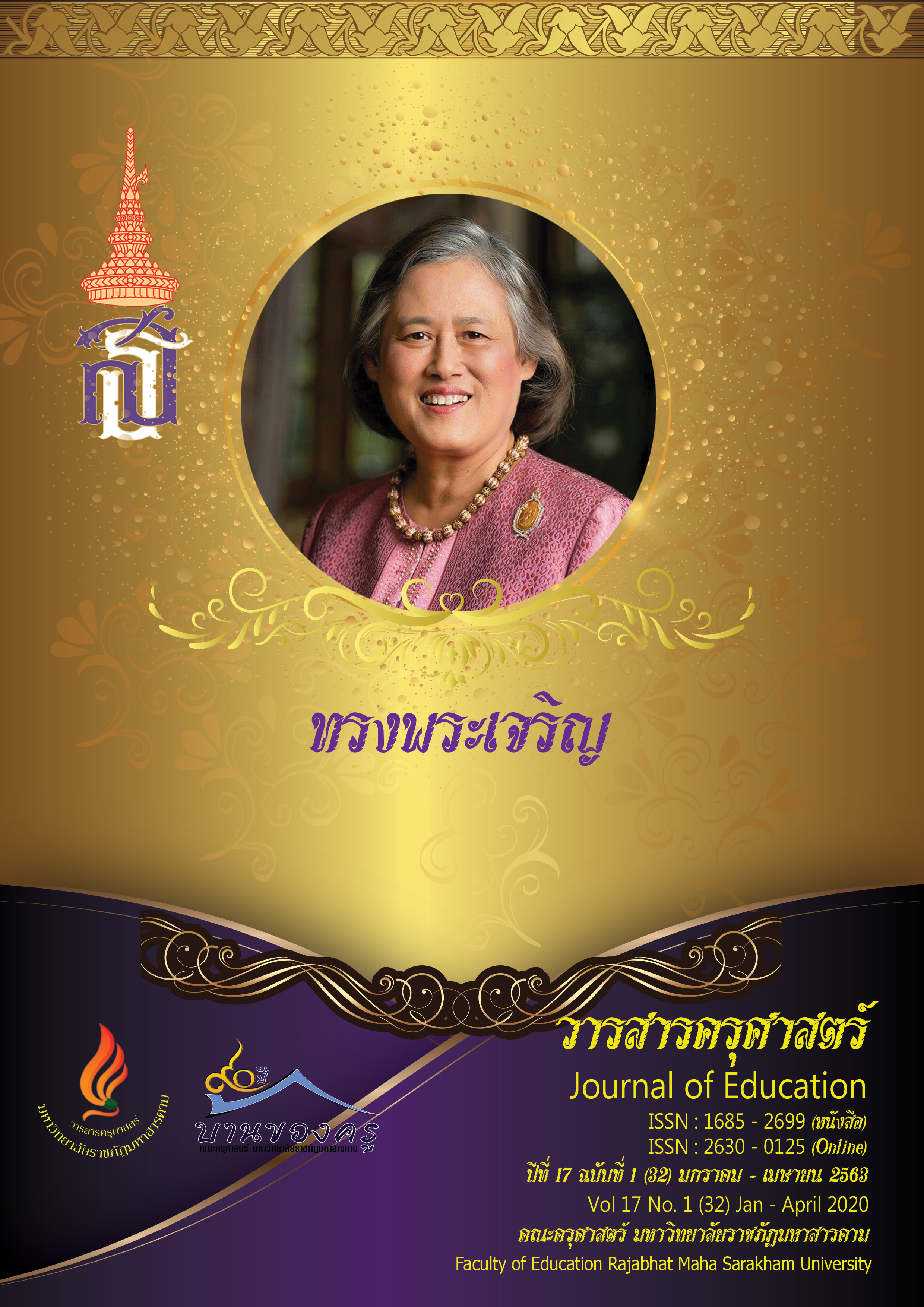ยุทธศาสตร์การพัฒนาการท่องเที่ยวเชิงธรณีของอุทยานธรณีขอนแก่นสูอุ่ทยานธรณีโลกของยูเนสโก
Main Article Content
บทคัดย่อ
การวิจัยนี้มีวัตถุประสงค์เพื่อสร้างและประเมินยุทธศาสตร์การพัฒนาการท่องเที่ยวเชิงธรณีของอุทยานธรณี
ขอนแกน่ สูอุ่ทยานธรณีโลกของยูเนสโก ใชก้ ารวิจัยแบบผสมผสานวิธีระหวา่ งการวิจัยเชิงคุณภาพสำหรับสรา้ งยุทธศาสตร ์
เก็บรวบรวมข้อมูลการสัมภาษณ์เชิงลึก การประชุมระดมความคิด และการสนทนากลุ่มกับคณะทำงานอุทยานธรณี
ขอนแก่น จำนวน 55 คน โดยใช้การวิเคราะห์ด้วยเทคนิค SWOT Analysis และ TOWS Metrix และการวิจัยเชิง
ปริมาณสำหรับการประเมินยุทธศาสตร ์ เก็บรวบรวมขอ้ มูลโดยใชแ้ บบประเมินยุทธศาสตรก์ ับผูเ้ ชี่ยวชาญดา้ นการทอ่ งเที่ยว
เชิงธรณีและอุทยานธรณีในระดับชาติและระดับโลก จำนวน 9 คน สถิติที่ใช้ในการวิเคราะห์ข้อมูล ได้แก่ ค่าเฉลี่ย และ
ส่วนเบี่ยงเบนมาตรฐาน
ผลการวิจัยพบว่า ยุทธศาสตร์ที่สร้างขึ้นมีวิสัยทัศน์ คือ อุทยานธรณีขอนแก่นเป็นอุทยานการท่องเที่ยว
ไดโนเสาร์และภูมิปัญญาระดับโลกประกอบด้วย 5 พันธกิจ, 5 วัตถุประสงค์, 5 ประเด็นยุทธศาสตร์, 11 เป้าประสงค์,
22 กลยุทธ์, 34 ตัวชี้วัด และ 78 โครงการ โดยประเด็นยุทธศาสตร์ ได้แก่ (1) อนุรักษ์และปกป้องแหล่งมรดกทางธรณี
อย่างมีส่วนร่วม (2) บริหารจัดการอุทยานธรณีแบบองค์รวมสู่เครือข่ายระดับโลก (3) ยกระดับสู่เมืองท่องเที่ยว
ไดโนเสาร์และภูมิปัญญาระดับโลก (4) ส่งเสริมการศึกษาและสื่อความหมายเพื่อการท่องเที่ยวเชิงธรณีด้วยนวัตกรรม
และ (5) พัฒนาเศรษฐกิจท้องถิ่นอย่างยั่งยืน ส่วนการประเมินยุทธศาสตร์ พบว่า มีความเหมาะสม ( = 4.54, S.D. = .569)
และความเป็นไปได้ในการนำไปปฏิบัติอยู่ในระดับมาก ( = 4.50, S.D. = .591)
Article Details
ข้อกำหนดเบื้องต้นที่ผู้นิพนธ์(ผู้ส่งบทความ) ควรทราบ
1. ผู้นิพนธ์ที่ประสงค์จะลงตีพิมพ์บทความกับวารสาร ตั้งแต่เดือนมกราคม 2563 เป็นต้นไป ให้ใช้รูปแบบใหม่ (Template 2563) โดยสามารถดูตัวอย่างได้ที่เมนู GUIDELINES
2. จะตีพิมพ์และเผยแพร่ได้ ต้องผ่านการประเมินจากผู้ทรงคุณวุฒิ (Peer Review)
3. การประเมินบทความโดยผู้ทรงคุณวุฒิ (Peer Review) เป็นแบบ Double Blind
4. การอ้างอิงบทความใช้หลักเกณฑ์ APA (American Psychological Association) คลิก
5. บทความถูกปฏิเสธการตีพิมพ์ ไม่ผ่านการประเมิน ผู้นิพนธ์ขอยกเลิกเองหรือชำระเงินก่อนได้รับการอนุมัติ ทางวารสารไม่มีนโยบายการคืนเงิน
เอกสารอ้างอิง
_______ . (2558). แผนแม่บทการบริหารจัดการธรณีวิทยาและทรัพยากรธรณี พ.ศ. 2562-2558. กรุงเทพมหานคร:กรมทรัพยากรธรณี.
_______ . (2558). แผนแม่บทการบริหารจัดการอุทยานธรณีสตูล. กรุงเทพมหานคร: กรมทรัพยากรธรณี.
_______ . (2562, 12 กรกฎาคม). ข่าวแจงการค้นพบไดโนเสาร์ชนิดใหม่ของประเทศไทย. กรุงเทพมหานคร:สืบค้นจาก http://www.dmr.go.th/
กระทรวงการท่องเที่ยวและกีฬา. (2560, 5 พฤศจิกายน). ยุทธศาสตร์การพัฒนาการท่องเที่ยวของกระทรวงการท่องเที่ยวและกีฬา พ.ศ. 2560-2564. สืบค้นจาก https://mots.go.thกัลยา วานิชย์บัญชา. (2549). สถิติสำหรับงานวิจัย (พิมพ์ครั้งที่ 2). กรุงเทพมหานคร:โรงพิมพ์จุฬาลงกรมหาวิทยาลัย.
จิรศักดิ์ เจริญมิตร, ศิริกรณ์ ถวาย และมนตรี แก่นทอง. (2555). รายงานการสำรวจแหล่งธรณีวิทยาจังหวัดขอนแก่น (รายงานวิชาการอนุรักษ์ธรณีวิทยา 1/2555). กรุงเทพมหานคร: กรมทรัพยากรธรณี.
ดำรงค์ วัฒนา. (2545). คู่มือการจัดทำแผนยุทธศาสตร์สำหรับหน่วยงานภาครัฐ: ยุทธศาสตร์สู่ผลงาน. กรุงเทพมหานคร: สำนักที่ปรึกษากรมอนามัย กระทรวงสาธารณสุข.
ศุภมิตร จันทะคาม. (2559). การท่องเที่ยวเชิงธรณีปรากฏการใหม่ของการพัฒนาท่องเที่ยวที่ยั่งยืน ในรายงานผลการดำเนินงาน ประจำปีงบประมาณ พ.ศ.2559 (ตุลาคม 2558 - กันยายน 2559). ขอนแก่น:สำนักงานทรัพยากรธรณี เขต 2 กรมทรัพยากรธรณี.
_______. (2560). แนวทางการพัฒนาการบริหารจัดการแหล่งท่องเที่ยวเชิงธรณีวิทยาของอุทยานธรณีขอนแก่น อำเภอเวียงเก่า จังหวัดขอนแก่น (วิทยานิพนธ์ปริญญารัฐประศาสนศาสตรมหาบัณฑิต). มหาวิทยาลัยราชภัฎสุราษฎร์ธานี, สุราษฎร์ธานี.
_______. (2561). แนวทางการพัฒนาศักยภาพแหล่งธรณีวิทยาเพื่อการท่องเที่ยวเชิงธรณีของอุทยานธรณีขอนแก่น อำเภอเวียงเก่า จังหวัดขอนแก่น (รายงานผลการวิจัย). ขอนแก่น: กรมทรัพยากรธรณี.
ศุภมิตร จันทะคาม และชมพูนุช ชาญวิชา. (2558). การศึกษาการระดมความคิดเห็นด้านการบริหารจัดการและพัฒนาแหล่งอนุรักษ์ธรณีวิทยาเพื่อการพัฒนาอย่างยั่งยืน ในพื้นที่หุบเขาไดโนเสาร์ดึกดำบรรพ์(รายงานผลการวิจัย). ขอนแก่น: กรมทรัพยากรธรณี.
สำนักงานจังหวัดขอนแก่น. (2560). แผนยุทธศาสตร์การพัฒนาจังหวัดขอนแก่น พ.ศ. 2560-2564. ขอนแก่น:สำนักงานจังหวัดขอนแก่น.
_______. (2561). การแต่งตั้งคณะกรรมการอำนวยการอุทยานธรณีขอนแก่น. ขอนแก่น: สำนักงานจังหวัดขอนแก่น.
สำนักงานอุทยานธรณีโคราช. (2560). แนวทางการบริหารจัดการแหล่งธรณีวิทยา แหล่งอนุรักษ์ธรณีวิทยาหรืออุทยานธรณีจังหวัดนครราชสีมา. นครราชสีมา: สำนักงานจังหวัดนครราชสีมา.
สำนักบริหารยุทธศาสตร์กลุ่มจังหวัดร้อยแก่นสารสินธุ์. (2560). แผนพัฒนากลุ่มจังหวัดภาคตะวันออกเฉียงเหนือตอนกลาง พ.ศ. 2561-2564. ร้อยเอ็ด: สำนักบริหารยุทธศาสตร์กลุ่มจังหวัดร้อยแก่นสารสินธุ์.
สุรชัย ศิริพงษ์เสถียร. (2556). ปัญหาการบริหารจัดการอุทยานธรณีประเทศไทย. นนทบุรี: สถาบันพระปกเกล้า.
สุวิมล ติรกานันท์. (2551). การสร้างเครื่องมือวัดตัวแปรในการวิจัยทางสังคมศาสตร์: แนวทางสู่การปฏิบัติ.กรุงเทพมหานคร: โรงพิมพ์แห่งจุฬาลงกรณ์มหาวิทยาลัย.
Antic, A., and Tomic, N. (2017). Geoheritage and geotourism potential of the Homolje area (Eastern Serbia). Journal of Acta Geoturistica, 8(1), 67-78.
Certo, S. C., and Peter, P. J. (1988). Strategic management concepts and applications (1st ed.).New York: Random House, Business Division.
Danek, T., and Skupien, P. (2016). Geotourism aspects of the Lufeng Dinosaur National Geopark in Yunnan Province, China. Journal of GeoScience Engineering, LXII(1), 51-57. Retrieved fromhttps://www.researchgate.net/publication/306085444_Geotourism_Aspects_of_the_Lufeng_Dinosaur_National_Geopark_in_Yunnan_Province_China
Dowling, R. K. (2008). The emergence of geotourism and geoparks. Journal of Tourism, 9(2),227–236.
Dowling, R. K. (2010). Geotourism’s global growth. Journal of Geoheritage, 3(1), 1-13.
Farsani, N. T., Coelho, C., and Coasta, C. (2011). Geotourism and geoparks as gateways to sociocultural sustainability in Qeshm Rural area, Iran, Asia Pacific. International Journal ofTourism Research, 13(1), 68 - 81. doi: 10.1002/jtr.800
_______ . (2014). Geo-knowledge management and geoconservation via geoparks and geotourism. Journal of Geoheritage, 6(3), 185–192. doi: 10.1007/s12371-014-0099-7
Gray, M. (2008). Geodiversity: Developing the paradigm. Proceeding of the geologists’ association,119(3-4), 287-298. doi: 10.1016/S0016-7878(08)80307-0 Hose, T. A. (2012). 3G’s for modern geotourism. Journal of Geoheritage, 4(1-2), pp. 7–24.doi: 10.1007/s12371-011-0052-y
Joyce, E. B. (2006). Geomorphological sites and the new geotourism in Australia. Journal ASEG Extended Abstracts, 2006(1), 1-4. doi: 10.1071/ASEG2006ab078
Newsome, D., and Dowling, R. K. (2006). Geotourism’s issues and challenges. In Geotourism,Part Three: Geotourism in Action - Chapter 13 (pp. 242-254). Elsevier, Oxford.
_______ . (2010). Global geotourism perspectives. Oxford, UK: Goodfellow Publishers.Olafsdottir, R., and Tverijonaite, E. (2018). Geotourism: A systematic literature review.Geosciences (Switzerland), 8(7), 1-16. doi: 10.3390/geosciences8070234
UNESCO. (2015). Global geoparks network. Geoparks secretariat, global earth Observations section,division of ecological and earth sciences, Paris. Retrieved from http://www2.unwto.org
_______. (2017). UNWTO annual report 2017. Retrieved from http://www2.unwto.org
Marlina, E. (2016). Geotourism as a strategy of geosite empowerment towards the tourism sustainability in gunungkidul regency, Indonesia. International Journal of Smart Home,10(5), 131-148.


